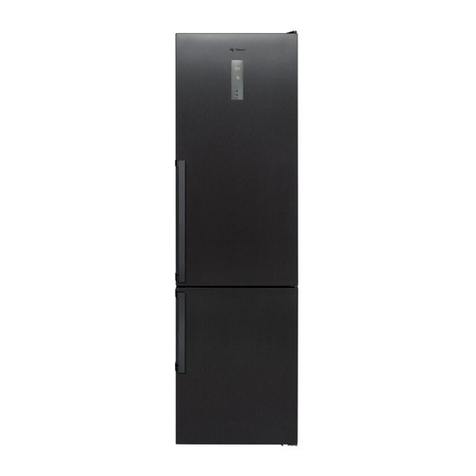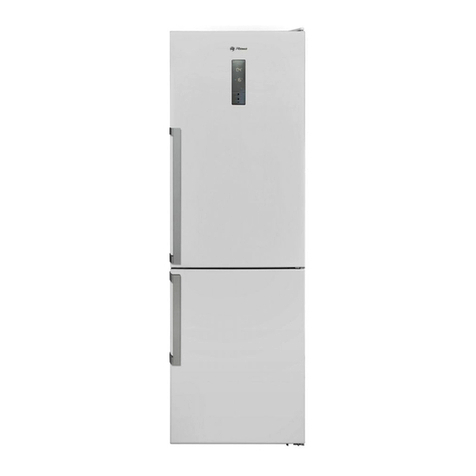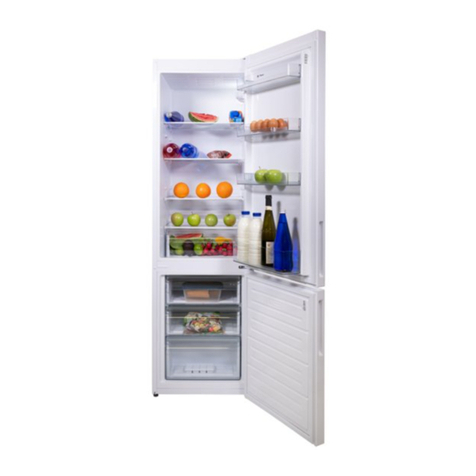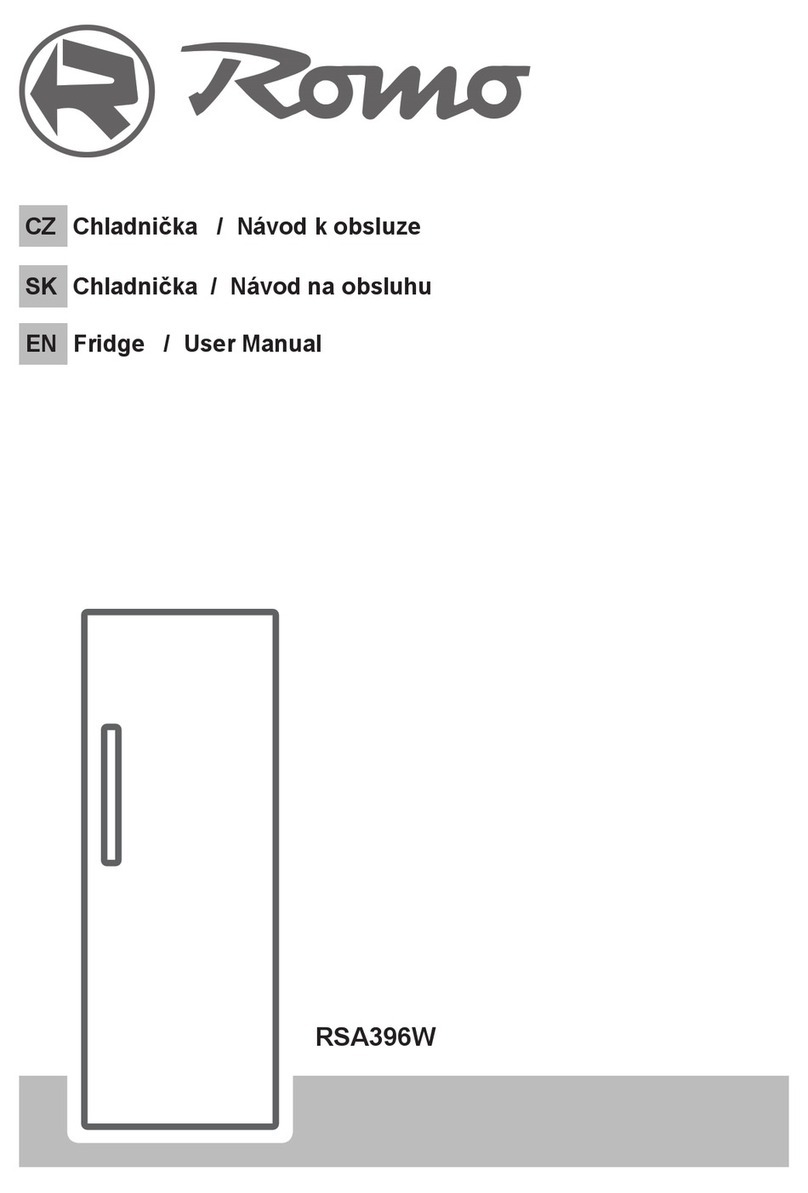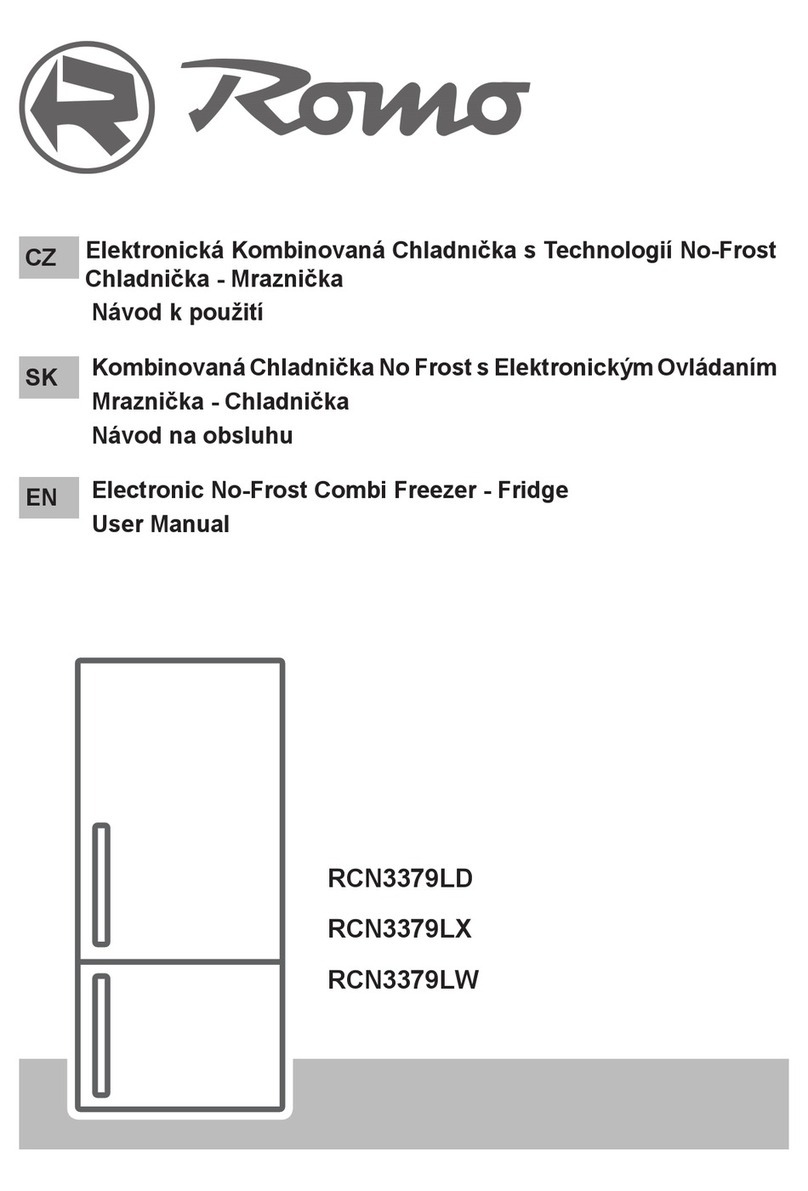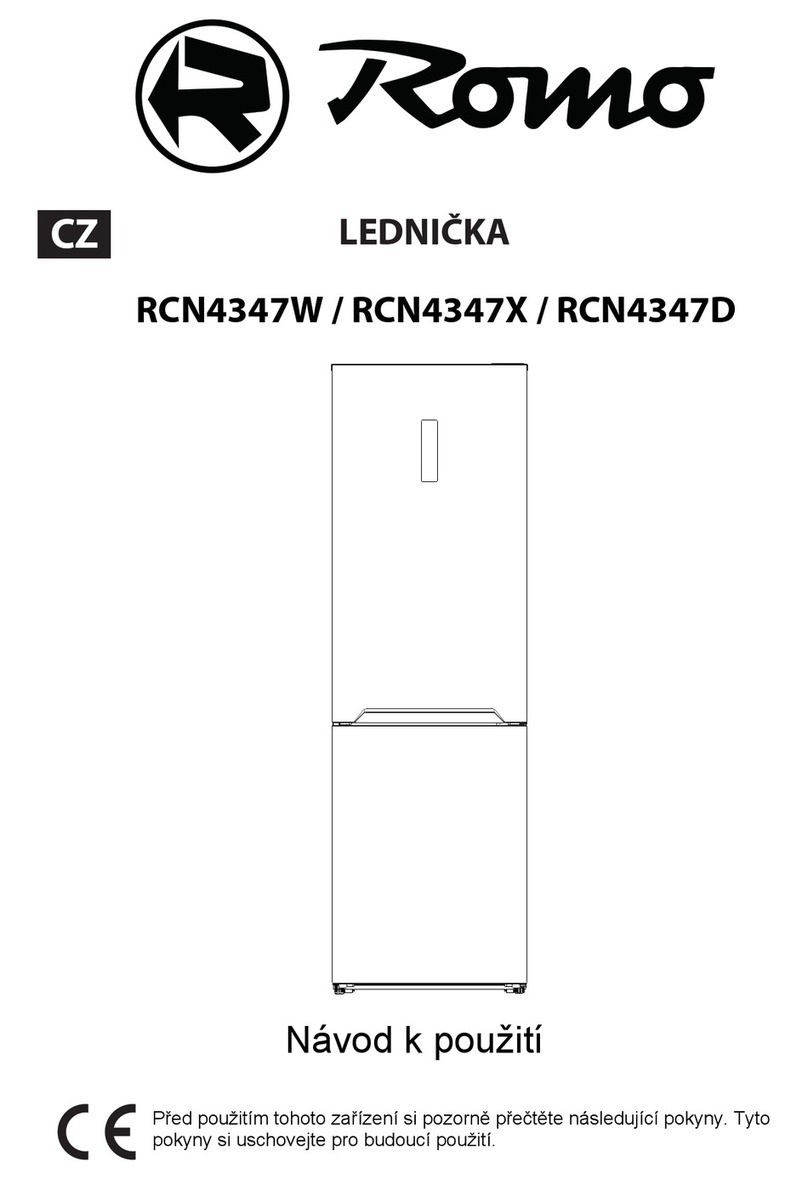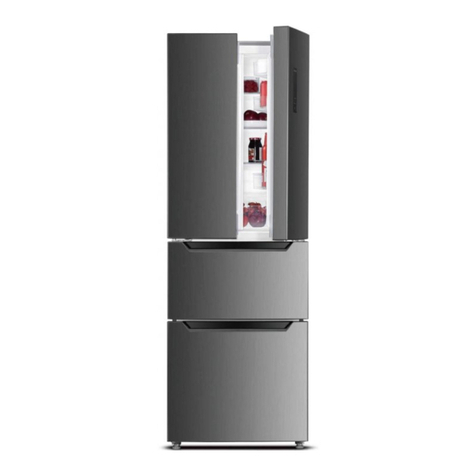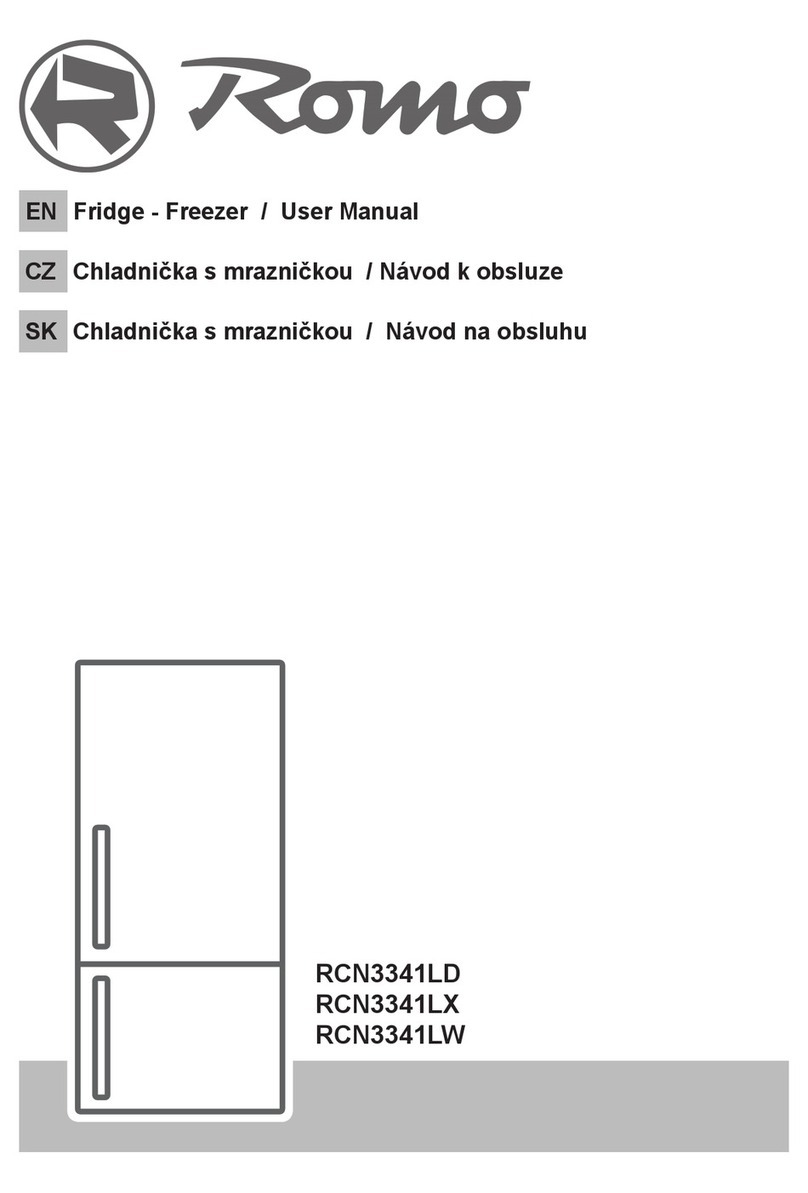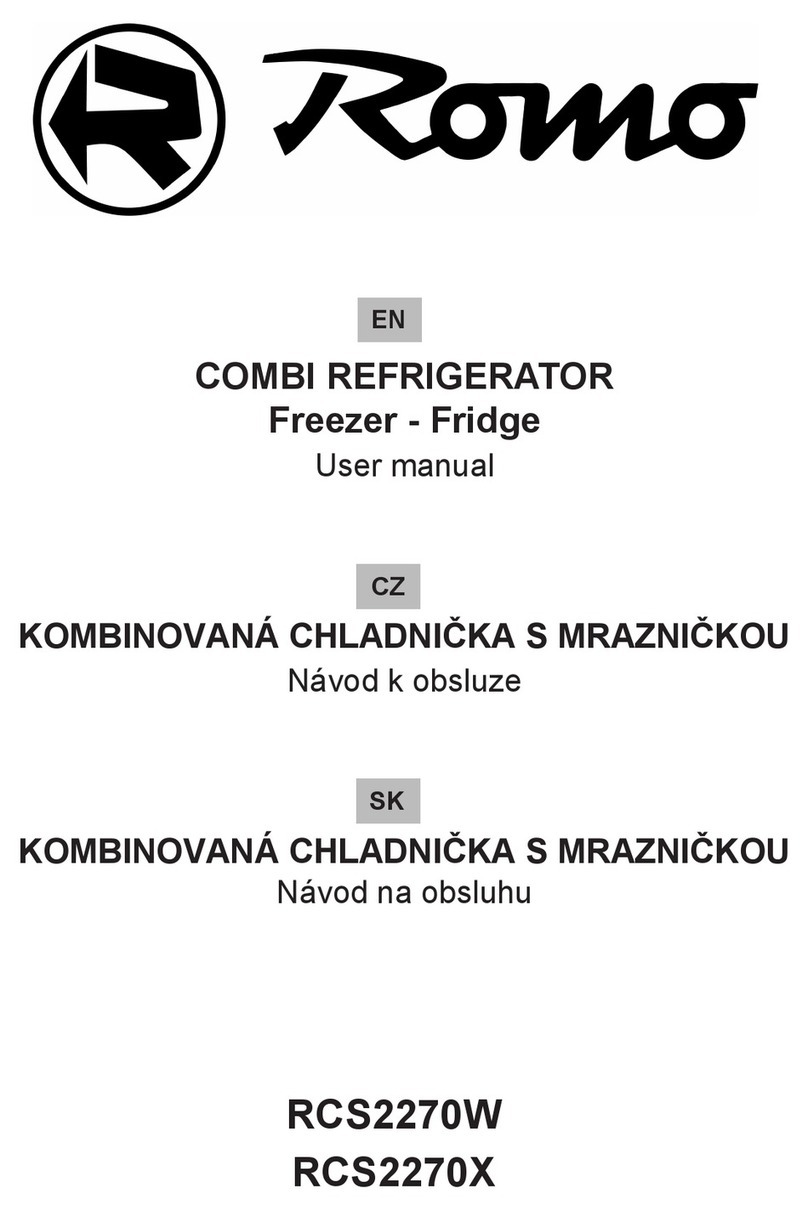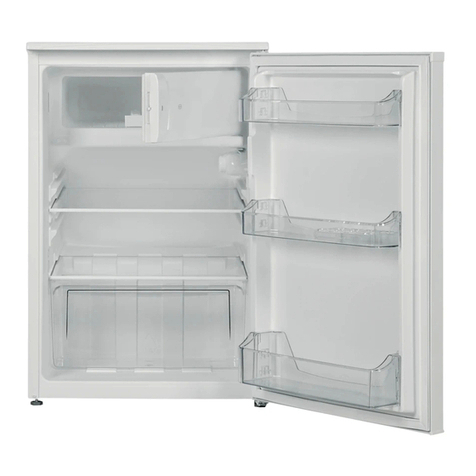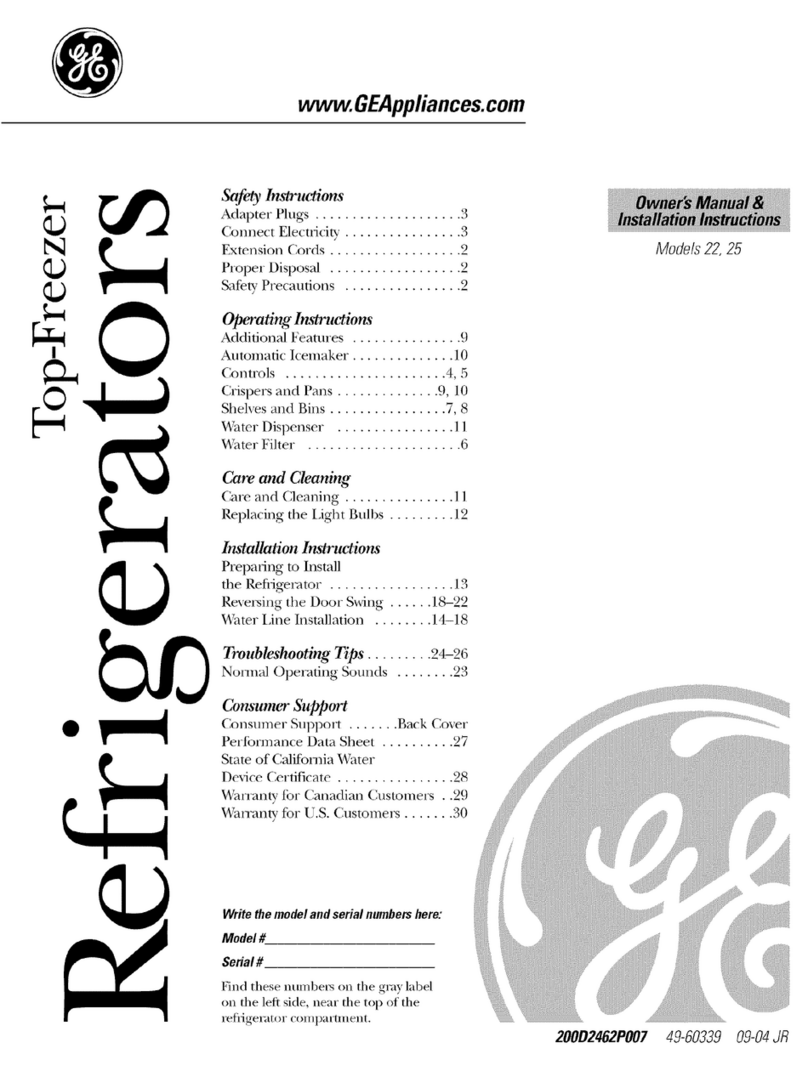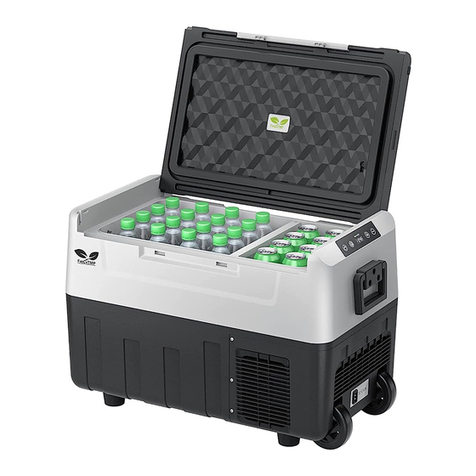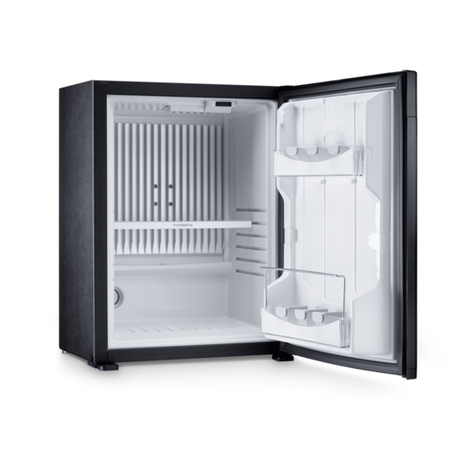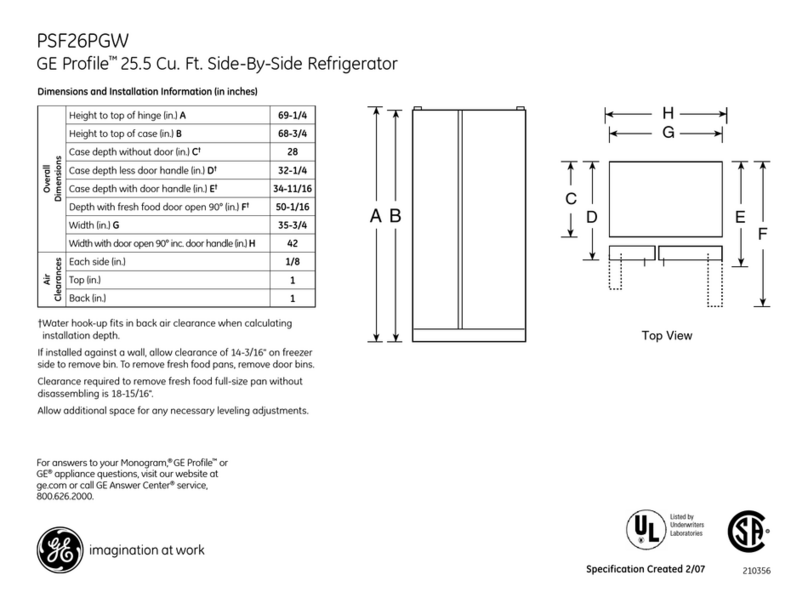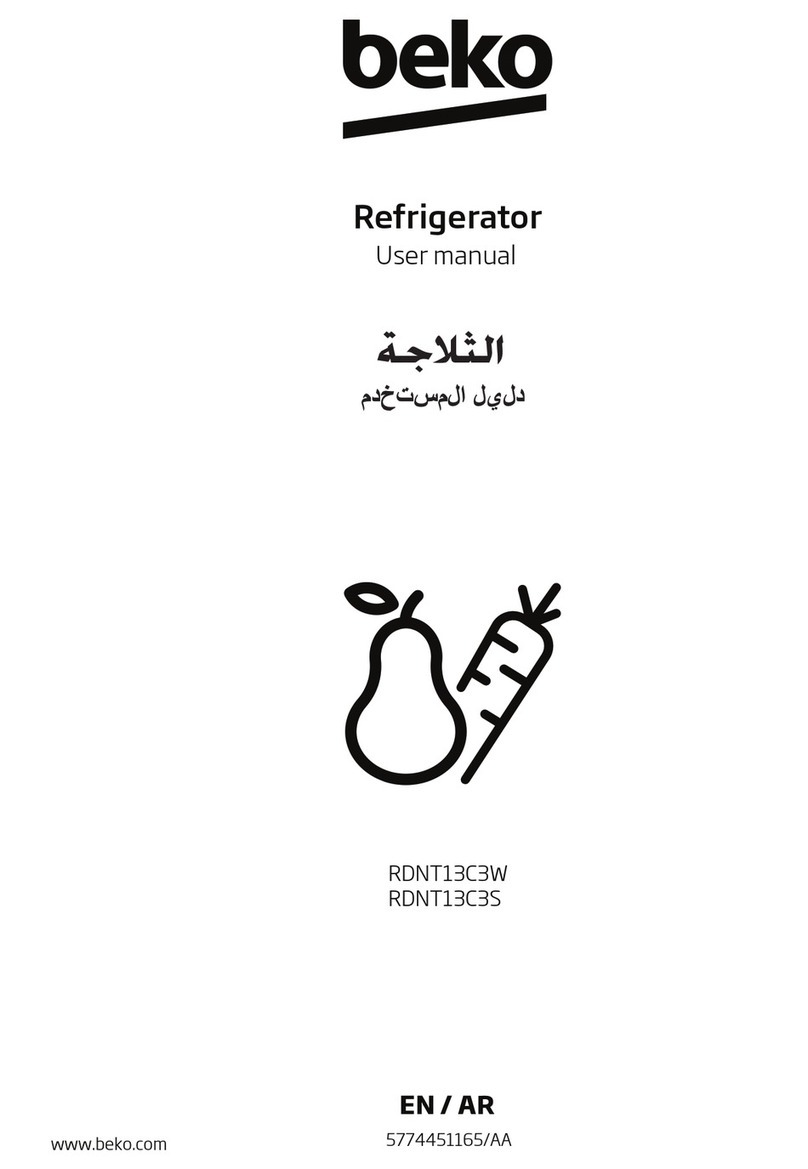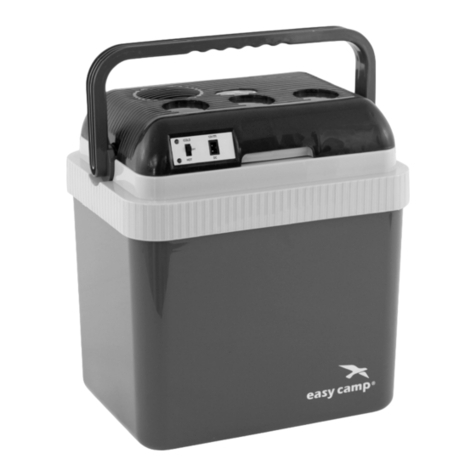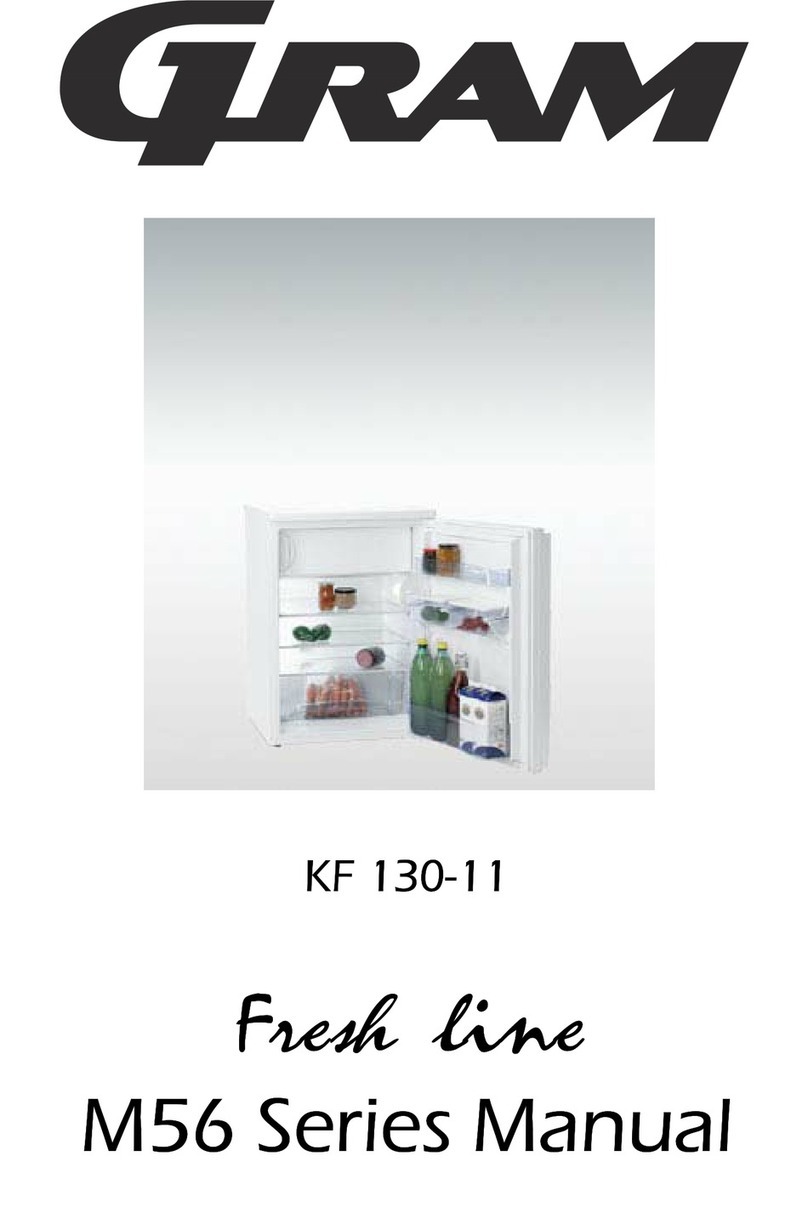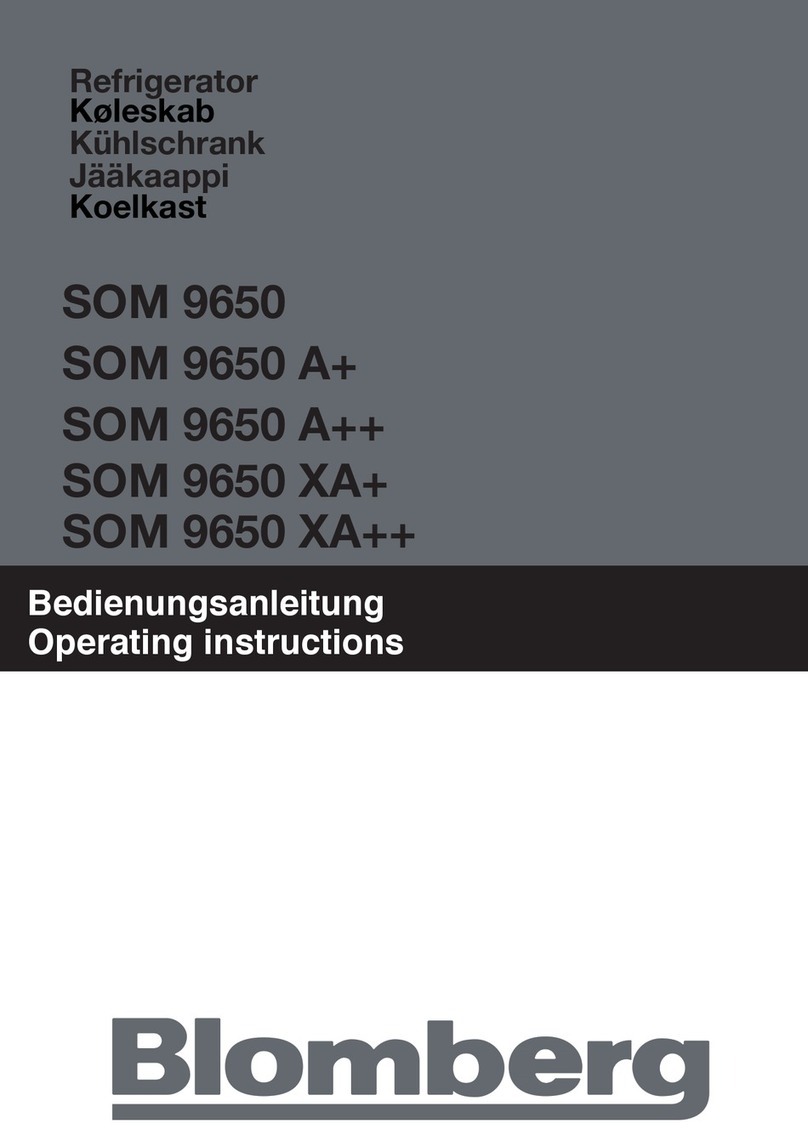Romo RT2134W User manual

F5,'*( / User Manual
LEDNIČKA / Návod k Obsluze
CHLADNIČKA / Používateľská príručka

EN FIRE ! Warning; Risk of re / ammable materials

EN - 3 -
CONTENTS
BEFORE USING THE APPLIANCE .......................................................... 4
General warnings ........................................................................................4
Old and out-of-order fridges or freezer ........................................................7
Safety warnings ...........................................................................................7
Installing and operating your fridge .............................................................8
Before Using your Fridge.............................................................................9
USING THE APPLIANCE .......................................................................... 9
Thermostat Setting ......................................................................................9
Temperature Settings Warnings ................................................................10
FOOD STORAGE .................................................................................... 11
Refrigerator Compartment......................................................................... 11
CLEANING AND MAINTENANCE .......................................................... 13
Defrosting ..................................................................................................14
Replacing the Light Bulb............................................................................14
SHIPMENT AND REPOSITIONING......................................................... 15
Repositioning the Door ..............................................................................15
BEFORE CALLING AFTER-SALES SERVICE....................................... 15
Tips For Saving Energy .............................................................................17
DESCRIPTION OF THE APPLIANCE ..................................................... 18
The operating instructions apply to several models. Dierences may therefore occur.

EN - 4 -
BEFORE USING THE APPLIANCE
General warnings
WARNING: Keep ventilation openings, in the appliance
enclosure or in the built-in structure, clear of obstruction.
WARNING: Do not use mechanical devices or other means
to accelerate the defrosting process, other than those
recommended by the manufacturer.
WARNING: Do not use electrical appliances inside the food
storage compartments of the appliance, unless they are of the
type recommended by the manufacturer.
WARNING: Do not damage the refrigerant circuit.
WARNING: When positioning the appliance, ensure the
supply cord is not trapped or damaged.
WARNING: Do not locate multiple portable socket-outlets or
portable power supplies at the rear of the appliance.
WARNING: In order to avoid any hazards resulting from the
instability of the appliance, it must be xed in accordance with
the following instructions:
If your appliance uses R600a as a refrigerant (this information
will be provided on the label of the cooler) you should take care
during transportation and installation to prevent the cooler
elements from being damaged. R600a is an environmentally
friendly and natural gas, but it is explosive. In the event of a leak
due to damage of the cooler elements, move your fridge away
from open ames or heat sources and ventilate the room where
the appliance is located for a few minutes.
• While carrying and positioning the fridge, do not damage the
cooler gas circuit.
• Do not store explosive substances such as aerosol cans with
a ammable propellant in this appliance.
PART - 1.

EN - 5 -
• This appliance is intended to be used in household and
domestic applications such as:
- sta kitchen areas in shops, oces and other working
environments.
- farm houses and by clients in hotels, motels and other
residential type environments.
- bed and breakfast type environments;
- catering and similar non-retail applications.
• If the socket does not match the refrigerator plug, it must be
replaced by the manufacturer, a service agent or similarly
qualied persons in order to avoid a hazard.
• A specially grounded plug has been connected to the power
cable of your refrigerator. This plug should be used with
a specially grounded socket of 16 amperes. If there is no
such socket in your house, please have one installed by an
authorised electrician.
• This appliance can be used by children aged from 8 years
and above and persons with reduced physical, sensory or
mental capabilities or lack of experience and knowledge if
they have been given supervision or instruction concerning
use of the appliance in a safe way and understand the hazards
involved. Children shall not play with the appliance. Cleaning
and user maintenance shall not be made by children without
supervision.
• Children aged from 3 to 8 years are allowed to load and
unload refrigerating appliances. Children are not expected
to perform cleaning or user maintenance of the appliance,
very young children (0-3 years old) are not expected to use
appliances, young children (3-8 years old) are not expected to
use appliances safely unless continuous supervision is given,
older children (8-14 years old) and vulnerable people can
use appliances safely after they have been given appropriate
supervision or instruction concerning use of the appliance.

EN - 6 -
Very vulnerable people are not expected to use appliances
safely unless continuous supervision is given.
• If the supply cord is damaged, it must be replaced by the
manufacturer, an authorised service agent or similar qualied
persons, in order to avoid a hazard.
• This appliance is not intended for use at altitudes exceeding
2000 m.
To avoid contamination of food, please respect the following
instructions:
• Opening the door for long periods can cause a signicant
increase of the temperature in the compartments of the
appliance.
• Clean regularly surfaces that can come in contact with food
and accessible drainage systems.
• Store raw meat and sh in suitable containers in the
refrigerator, so that it is not in contact with or drip onto other
food.
• Two-star frozen-food compartments are suitable for storing
pre-frozen food, storing or making ice cream and making ice
cubes.
• One-, two- and three-star compartments are not suitable for
the freezing of fresh food.
• If the refrigerating appliance is left empty for long periods,
switch o, defrost, clean, dry, and leave the door open to
prevent mould developing within the appliance.

EN - 7 -
Old and out-of-order fridges or freezer
• If your old fridge or freezer has a lock, break or remove the lock before discarding it,
because children may get trapped inside it and may cause an accident.
• Old fridges and freezers contain isolation material and refrigerant with CFC. Therefore,
take care not to harm environment when you are discarding your old fridges.
Disposal of your old appliance
The symbol on the product or on its packaging indicates that this product may not
be treated as household waste. Instead it shall be handed over to the applicable
collection point for the recycling of electrical and electronic equipment. By
ensuring this product is disposed of correctly, you will help prevent potential
negative consequences for the environment and human health, which could
otherwise be caused by inappropriate waste handling of this product. For more
detailed information about recycling of this product, please contact your local city oce, your
household waste disposal service or the shop where you purchased the product.
Notes:
• Please read the instruction manual carefully before installing and using your appliance.
We are not responsible for the damage occurred due to misuse.
• Follow all instructions on your appliance and instruction manual, and keep this manual in
a safe place to resolve the problems that may occur in the future.
• This appliance is produced to be used in homes and it can only be used in domestic
environments and for the specied purposes. It is not suitable for commercial or
common use. Such use will cause the guarantee of the appliance to be cancelled and
our company will not be responsible for the losses to be occurred.
• This appliance is produced to be used in houses and it is only suitable for cooling / storing
foods. It is not suitable for commercial or common use and/or for storing substances
except for food. Our company is not responsible for the losses to be occurred in the
contrary case.
Safety warnings
• Do not connect your fridge freezer to the mains electricity supply using an extension
lead.
• Do not use damaged, torn or old plugs.
• Do not pull, bend or damage the cord.
• Do not use plug adapter.
• This appliance is designed for use by adults. Do not allow children to play
with the appliance or hang o the door.
• Never touch the power cord/plug with wet hands. This may cause a short
circuit or electric shock.

EN - 8 -
• Do not place explosive or ammable material in your fridge. Place drinks with
high alcohol content vertically in the fridge compartment and make sure their
tops are tightly closed.
Installing and operating your fridge
Before using your fridge for the rst time, please pay attention to the following points:
• The operating voltage for your fridge is 220-240 V at 50Hz.
• The plug must be accessible after installation.
• Your fridge may have an odour when it is operated for the rst time. This is normal and
the odour will fade when your fridge starts to cool.
• Before connecting your fridge, ensure that the information on the data plate (voltage
and connected load) matches that of the mains electricity supply. If in doubt, consult a
qualied electrician.
• Insert the plug into a socket with an ecient ground connection. If the socket has no
ground contact or the plug does not match, we recommend you consult a qualied
electrician for assistance.
• The appliance must be connected with a properly installed fused socket. The power
supply (AC) and voltage at the operating point must match with the details on the name
plate of the appliance (the name plate is located on the inside left of the appliance).
• We do not accept responsibility for any damages that occur due to ungrounded usage.
• Place your fridge where it will not be exposed to direct sunlight.
• Your fridge must never be used outdoors or exposed to rain.
• Your appliance must be at least 50 cm away from stoves, gas ovens and heater cores,
and at least 5 cm away from electrical ovens.
• If your fridge is placed next to a deep freezer, there must be at least 2 cm between them
to prevent humidity forming on the outer surface.
• Do not cover the body or top of fridge with lace. This will aect the performance of your
fridge.
• Clearance of at least 150 mm is required at the top of your appliance. Do not
place anything on top of your appliance.
• Do not place heavy items on the appliance.
• Use the adjustable front legs to make sure your appliance is level and stable.
You can adjust the legs by turning them in either direction. This must be done
before placing food in the appliance.
• Clean the appliance thoroughly before use (see Cleaning and Maintenance).
• Before using your fridge, wipe all parts with a solution of warm water and a teaspoon of
sodium bicarbonate. Then, rinse with clean water and dry. Return all parts to the fridge
after cleaning.
• Install the two plastic distance guides (the parts on the black vanes
-condenser- at the rear) by turning it 90° (as shown in the gure) to
prevent the condenser from touching the wall.
• The distance between the appliance and back wall must be a maximum
of 75 mm.

EN - 9 -
Before Using your Fridge
• When using your fridge for the rst time, or after transportation, keep it in
an upright position for at least 3 hours before plugging into the mains. This
allows ecient operation and prevents damage to the compressor.
• Your fridge may have a smell when it is operated for the rst time. This is normal and the
smell will fade away when your fridge starts to cool.
USING THE APPLIANCE
PART - 2.
Thermostat Setting
The fridge thermostat automatically regulates
the temperature of the compartment. Fridge
temperatures can be obtained by rotating the
knob to higher numbers, 1 to 5.
Important note: Do not try to rotate the
knob beyond position 1, it will stop your
appliance from working.
Thermostat Settings
• Set the knob to a low/medium position, up to 3, for short-term storage of food in the
appliance.
• Set the knob to a medium position, 3 or 4, for long-term storage of food in the appliance.
• For long-term storage of food in the refrigerator, you can set knop maximum position
(4 - 5).
Larders (coolers) have not any freezer compartment but can cool up to 4 - 6 °C.
Super freezing: This switch shall be
used as superfreeze switch. For maximum
freezing capacity, please turn on this switch
before 24 hours placing fresh food. After
placing fresh food in the freezer, 24 hours
ON position is generally sucient. In order
to save energy, please turn o this switch
after 24 hours from placingfresh food.
Super switch
(In some models)
Super switch
(In some models)Thermostat knob
Lamp cover

EN - 10 -
Temperature Settings Warnings
• The ambient temperature, temperature of the freshly stored food and how often the door
is opened aects the temperature in the fridge. If required, change the temperature
setting.
• It is not recommended that you operate your fridge in environments colder than 10°C in
terms of its eciency.
• When setting the thermostat, take into consideration how often the appliance door is
opened and closed, how much food is stored in the refrigerator, and the environment in
which the refrigerator is located.
• When the appliance is rst switched on, allow it to run for 24 hours in order to reach
operating temperature. During this time, do not open the door and do not keep a large
quantity of food inside.
• Unplug your appliance during a power cut to prevent damage to the compressor. Once
power is restored, delay plugging in your appliance for 5 to 10 minutes. This will help
prevent damage to the appliance's components.
• Your appliance is designed to operate in the ambient temperature ranges stated in
the standards, according to the climate class stated in the information label. It is not
recommended that your fridge is operated in the environments which are outside of the
stated temperature ranges. This will reduce the cooling eciency of the appliance.
• Your appliance is designed to operate in the ambient temperature (T/SN = 10°C - 43°C)
intervals stated in the standards, according to the climate class displayed on the
information label. We do not recommend operating your appliance out of the stated
temperature limits in terms of cooling eectiveness.
Climate class and meaning:
T (tropical): This refrigerating appliance is intended to be used at ambient temperatures
ranging from 16 °C to 43 °C.
ST (subtropical): This refrigerating appliance is intended to be used at ambient
temperatures ranging from 16 °C to 38 °C.
N (temperate): This refrigerating appliance is intended to be used at ambient temperatures
ranging from 16 °C to 32 °C.
SN (extended temperate): This refrigerating appliance is intended to be used at ambient
temperatures ranging from 10 °C to 32 °C.
Climate
Class Ambient Temperature oC
TBetween 16 and 43 (°C)
ST Between 16 and 38 (°C)
NBetween 16 and 32 (°C)
SN Between 10 and 32 (°C)

EN - 11 -
FOOD STORAGEPART - 3.
Refrigerator Compartment
• To reduce humidity and avoid the consequent formation of frost, always store liquids in
sealed containers in the refrigerator. Frost tends to concentrate in the coldest parts of
the evaporating liquid and, in time, your appliance will require more frequent defrosting.
• Never place warm food in the refrigerator. Warm food should be allowed to cool at room
temperature and should be arranged to ensure adequate air circulation in the refrigerator
compartment.
• Make sure no items are in direct contact with the rear wall of the appliance as frost will
develop and packaging will stick to it. Do not open the refrigerator door frequently.
• We recommend that meat and clean sh are loosely wrapped and stored on the glass
shelf just above the vegetable bin where the air is cooler, as this provides the best
storage conditions.
• Store loose fruit and vegetable items in the crisper containers.
• Store loose fruit and vegetables in the crisper.
• Storing fruit and vegetables separately helps prevent ethylene-sensitive vegetables
(green leaves, broccoli, carrot, etc.) being aected by ethylene-releaser fruits (banana,
peach, apricot, g etc.).
• Do not put wet vegetables into the refrigerator.
• Storage time for all food products depends on the initial quality of the food and an
uninterrupted refrigeration cycle before refrigerator storage.
• To avoid cross-contamination do not store meat products with fruit and vegetables.
Water leaking from meat may contaminate other products in the refrigerator. You should
package meat products and clean any leakages on the shelves.
• Do not put food in front of the air ow passage.
• Consume packaged foods before the recommended expiry date.
• For normal working conditions, it will be sucient to adjust the temperature setting of
your refrigerator to +4 °C.
• The temperature of the fridge compartment should be in the range of 0-8 °C, fresh foods
below 0 °C are iced and rotted, bacterial load increases above 8 °C, and spoils.
• Do not put hot food in the refrigerator immediately, wait for the temperature to pass
outside. Hot foods increase the degree of your refrigerator and cause food poisoning
and unnecessary spoiling of the food.
• Meat, sh, etc. should be store in the chiller compartment of the food, and the vegetable
compartment is preferred for vegetables. (if available)
• To prevent cross contamination, meat products and fruit vegetables are not stored
together.
• Foods should be placed in the refrigerator in closed containers or covered to prevent
moisture and odors.

EN - 12 -
NOTE: Potatoes, onions and garlic should not be stored in the refrigerator.
The table below is a quick guide to show you the most ecient way to store the major food
groups in your refrigerator compartment.
Food Maximum storage time How and where to store
Vegetables and fruits 1 week Vegetable bin
Meat and sh 2 - 3 Days Wrap in plastic foil, bags, or in a meat
container and store on the glass shelf
Fresh cheese 3 - 4 Days On the designated door shelf
Butter and margarine 1 week On the designated door shelf
Bottled products e.g. milk and
yoghurt
Until the expiry date
recommended by the
producer
On the designated door shelf
Eggs 1 month On the designated egg shelf
Cooked food 2 Days All shelves

EN - 13 -
CLEANING AND MAINTENANCEPART - 4.
Disconnect the unit from the power supply before cleaning.
Do not wash your appliance by pouring water on it.
Do not use abrasive products, detergents or soaps for cleaning the
appliance. After washing, rinse with clean water and dry carefully. When you
have nished cleaning, reconnect the plug to the mains supply with dry
hands.
• Make sure that no water enters the lamp housing and other electrical components.
• The appliance should be cleaned regularly using a solution of bicarbonate
of soda and lukewarm water.
• Clean the accessories separately by hand with soap and water.
Do not wash accessories in a dish washer.
• Clean the condenser with a brush at least twice a year. This will help
you to save on energy costs and increase productivity.
The power supply must be disconnected during cleaning.

EN - 14 -
Defrosting
• Defrosting occurs automatically in the refrigerator compartment during operation. The
water is collected by the evaporation tray and evaporates automatically.
• The evaporation tray and the water drain hole should be cleaned periodically with the
defrost drain plug to prevent the water from collecting at the bottom of the refrigerator
instead of owing out.
• You can also clean the drain hole by pouring half a glass of water down it.
Replacing the Light Bulb
When replacing the light of the
refrigerator compartment;
1. 1. Unplug the unit from the
power supply,
2. 2. Press the hooks on the
sides of the light cover top
and remove the light cover
3. 3. Change the present light
bulb with a new one of not more than 15 W.
4. 4. Replace the light cover and after waiting
5. 5 minutes plug the unit.
Replacing LED Lighting
If your appliance has LED lighting contact the help desk as this should be changed by
authorized personnel only.

EN - 15 -
SHIPMENT AND REPOSITIONINGPART - 5.
Transportation and Changing Positioning
• The original packaging and foam may be kept for re-transportation (optional).
• Fasten your appliance with thick packaging, bands or strong cords and follow the
instructions for transportation on the packaging.
• Remove all movable parts (shelves, accessories, vegetable
bins, and so on) or x them into the appliance against
shocks using bands when re-positioning or transporting.
Always carry your appliance in the upright position.
Repositioning the Door
• It is not possible to change the opening direction of your appliance door if door handle is
installed on the front surface of the appliance door.
• It is possible to change the opening direction of the door on models without handle.
• If the door-opening direction of your appliance can be changed, contact the nearest
Authorised Service Centre to change the opening direction.
BEFORE CALLING AFTER-SALES SERVICE
PART - 6.
If your refrigerator is not working properly, there may be a minor problem. Check the following.
The appliance does not operate
Check if:
• Your fridge is plugged in and switched on
• The fuse has blown
• Is the temperature adjustment right?
• The socket is faulty. To check this, plug another working appliance into the same socket.
The appliance performs poorly
Check if:
• Is the temperature adjustment right?
• Is the door of your fridge opened frequently and left open for a long while?
• The appliance is overloaded
• The door is closed properly
• Is your fridge lled excessively?
• There is an adequate distance between the appliance and surrounding walls
• Is the ambient temperature within the range of values specied in the operating manual?
The appliance is noisy
The cooling gas which circulates in the refrigerator circuit may make a slight noise (bubbling
sound) even when the compressor is not running. Do not worry, this is normal. If you hear a
dierent sound, check whether:
• The appliance is level
• Anything is touching the rear of the appliance
• Objects in the appliance are vibrating.

EN - 16 -
Your refrigerator is operating noisily
The following noises can be heard during normal operation of the appliance.
Clicking noise occurs: When the thermostat switches the compressor on/o.
Motor noise: Indicates the compressor is operating normally. The compressor may
cause more noise for a short time when it is rst activated.
Bubbling noise and splashing occurs: Due to the ow of the refrigerant in the tubes
of the system.
Water owing noise occurs: Due to water owing to the evaporation container. This
noise is normal during defrosting.
There is water in the lower part of the refrigerator
Check if:
The drain hole for the water is not clogged (use defrost drain plug to clean the drain hole).
There is a build-up of humidity inside the fridge
Check if:
• All food is packed properly. Containers must be dry before being placed in the fridge.
• The fridge doors are opened frequently. Humidity of the room will enter the fridge each
time the doors are opened. Humidity increases faster if the doors are opened frequently,
especially if the humidity of the room is high.
The door is not opening or closing properly
Check if:
• There is food or packaging preventing the door from closing
• The door compartments, shelves and drawers are placed properly
• The door gaskets are broken or torn
• Your fridge is level.
Recommendations
• If the appliance is switched o or unplugged, wait at least 5 minutes before plugging the
appliance in or restarting it in order to prevent damage to the compressor.
• The cooling unit of your refrigerator is located at the rear of the appliance. Therefore,
water droplets or ice may form on the rear surface of your fridge due to the operation
of the compressor at specied intervals. This is normal, there is no need to perform a
defrosting operation unless there is excessive ice.
• If you do not intend to use your fridge for a long period of time (such as during the
summer holidays), disconnect the appliance from the mains, defrost and clean your
fridge, leaving the door open to prevent the formation of mildew and odour.
• If a problem persists after you have followed all the above instructions, please consult the
nearest authorised service centre.
• The appliance you have purchased is designed for domestic use only. It is not suitable
for commercial or common use. If the consumer uses the appliance in a way that does
not comply with this, we emphasise that the manufacturer and the dealer will not be
responsible for any repair and failure within the guarantee period.

EN - 17 -
Tips For Saving Energy
1. Install the appliance in a cool, well-ventilated room, but not in direct sunlight and not near
a heat source (such as a radiator or oven) otherwise an insulating plate should be used.
2. Allow warm food and drinks to cool before placing them inside the appliance.
3. Drinks or other liquids should be covered when inside the appliance. If left uncovered, the
humidity inside the appliance will increase, therefore the appliance uses more energy.
Keeping drinks and other liquids covered helps preserve their smell and taste.
4. Avoid keeping the doors open for long periods and opening the doors too frequently as
warm air will enter the appliance and cause the compressor to switch on unnecessarily
often.
5. Keep the covers of the dierent temperature compartments (such as the crisper and
chiller) closed.
6. The door gasket must be clean and pliable. In case of wear, if your gasket is detachable,
replace the gasket. If not detachable, you have to replace the door.

EN - 18 -
DESCRIPTION OF THE APPLIANCEPART - 7.
1
2
3
4
5
6
7
8
This presentation is only for information about the parts of the appliance.
Parts may vary according to the appliance model.
1) Thermostat box
2) Refrigerator shelves
3) Crisper cover
4) Crisper
5) Levelling feet
6) Bottle shelf
7) Door shelves
8) Egg holder
This appliance is not intended to be used as a built-in appliance.
General notes:
Fresh Food Compartment (Fridge): Most ecient use of energy is ensured in the
conguration with the drawers in the bottom part of the appliance, and shelves evenly
distributed, position of door bins does not aect energy consumption.
Freezer Compartment (Freezer): Most Ecient use of energy is ensured in the
conguration with the drawers and bins are on stock position.

EN - 19 -
1.1 Dimensions
H1
H2
Space required in use 2
H2 mm
W2 mm
D2 mm
Overall space required in use 3
W3 mm
D3 mm
Overall dimensions 1
H1 mm
W1 mm
D1 mm
W1
D1
W2
D2
W3
D3

CZ - 20 -
Obsah
PŘED POUŽITÍM SPOTŘEBIČE ............................................................. 21
Všeobecná upozornění ................................................................................... 21
Vysloužilé a nefunkční chladničky................................................................... 25
Varování .......................................................................................................... 25
Instalace a provoz Vaší chladničky ................................................................ 26
Před použitím Vaší chladničky ........................................................................ 26
POUŽÍVÁNÍ SPOTŘEBIČE ...................................................................... 27
Nastavení termostatu ...................................................................................... 27
Varování ohledně nastavení teploty ................................................................ 28
ČIŠTĚNÍ A ÚDRŽBA ................................................................................ 29
Odmrazování chladicího prostoru ................................................................... 29
Výměna žárovky.............................................................................................. 30
ROZMÍSTĚNÍ POTRAVIN VE SPOTŘEBIČI ........................................... 31
Chladicí prostor ............................................................................................... 31
PŘEPRAVA A ZMĚNA MÍSTA INSTALACE ............................................ 32
Změna otevírání dvířek ................................................................................... 32
NEŽ KONTAKTUJETE ZÁKAZNICKÝ SERVIS ...................................... 33
Tipy pro úsporu energie................................................................................... 35
POPIS SPOTŘEBIČE A JEHO ČÁSTÍ .................................................... 36
Table of contents
Languages:
Other Romo Refrigerator manuals
Popular Refrigerator manuals by other brands

ETNA
ETNA EEK262VA Instructions for use

Fisher & Paykel
Fisher & Paykel ACTIVESMART RF523M U Series user guide

Summit
Summit ADRD18 user manual
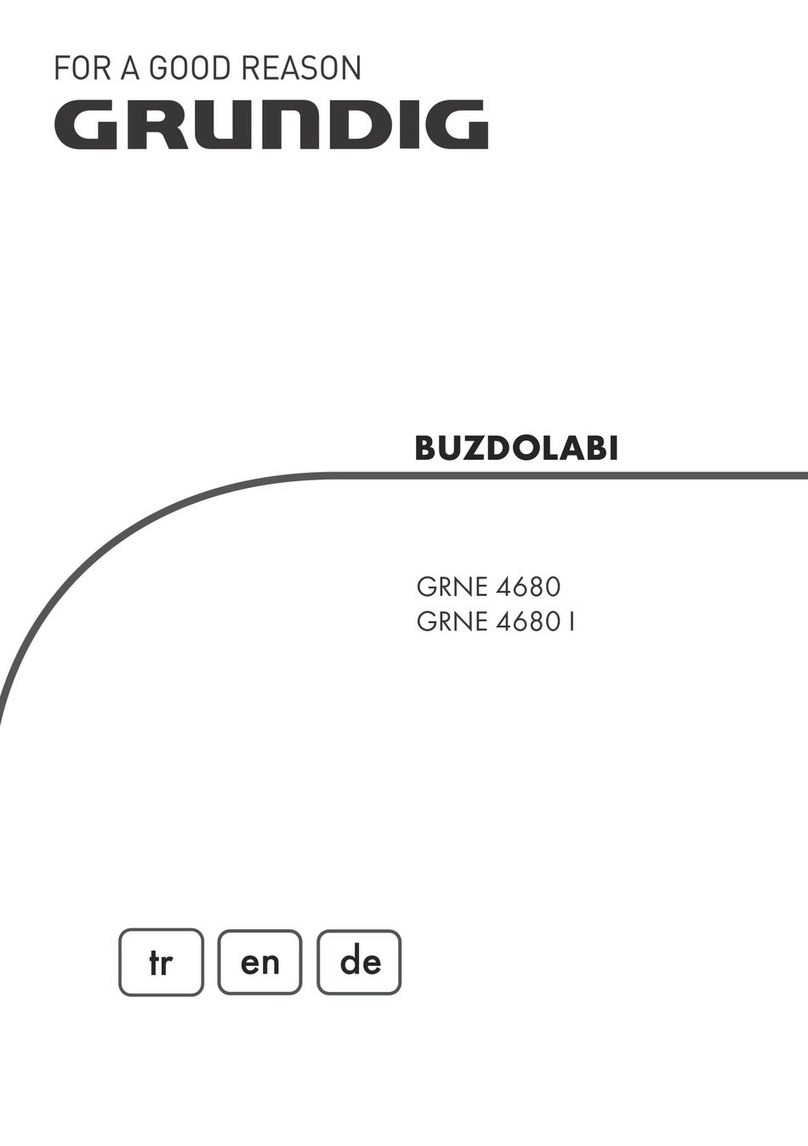
Grundig
Grundig GRNE 4680 instruction manual
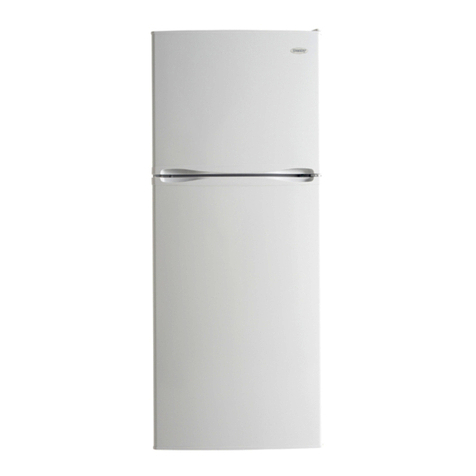
Simplicity
Simplicity SYFF123C1WL owner's manual
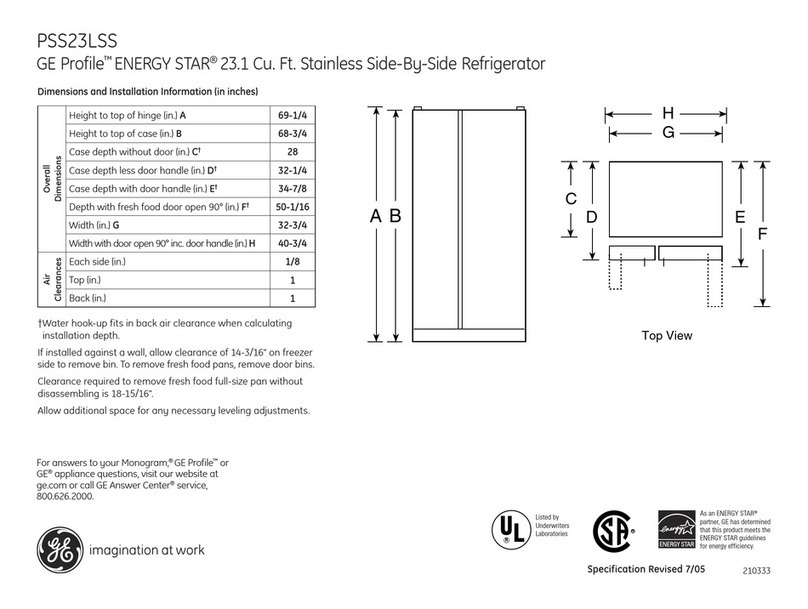
GE
GE GE Profile Energy Star PSS23LSS Dimensions and installation information

